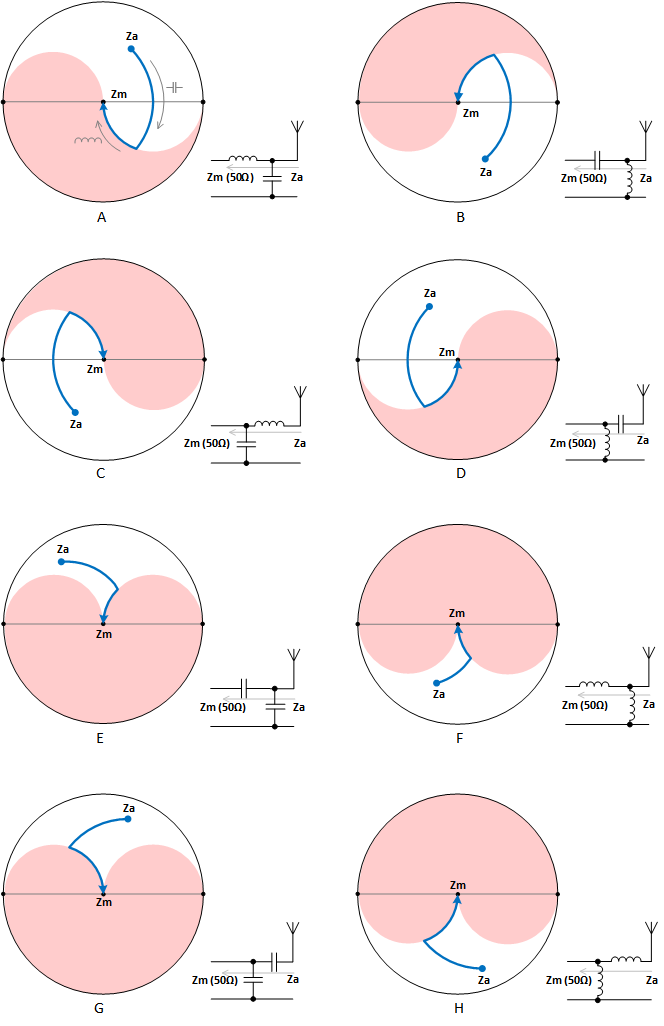SWRA726 March 2022 CC1120 , CC1121 , CC1201 , CC1310 , CC1311P3 , CC1311R3 , CC1312PSIP , CC1312R , CC1312R7 , CC1314R10 , CC1350 , CC1352P , CC1352R , CC1354P10 , CC1354R10 , CC2340R5-Q1 , CC2640R2L , CC2651R3 , CC2652P , CC2652P7 , CC2652R , CC2652R7 , CC2652RB , CC2652RSIP , CC3130 , CC3135MOD , CC3230S , CC3235MODAS , CC3235MODASF , CC3235MODSF , CC3235S , WL1801MOD , WL1805MOD , WL1807MOD , WL1831 , WL1831MOD , WL1835MOD , WL1837MOD
- Trademarks
- 1Introduction
- 2Antenna Standing Wave Ratio (SWR) Measurement
- 3Evaluation Board Matching Components Location
- 4Volpert-Smith Chart
- 5868-MHz PCB Helix Antenna Measurement and Matching
- 62.4-GHz PCB Compact Antenna Measurement and Matching
- 7 2.4-GHz PCB Inverted-F Antenna Measurement and Matching
- 8Fast in-circuit or in-device Antenna Verification
- 9Conclusion
4.1 Antenna Impedance Matching
Depending on what part of the Volpert-Smith chart a measured result of unmatched antenna is, there are eight combinations of matching networks (LC, LL and CC) which can help to transform measured antenna’s impedance to 50 Ohm value (that is, move it to the center of the chart) shown in the Figure 4-4. Important to remember, that Figure 4-4 represents measured impedance at only single specific frequency of interest. That is why there is only one point called Za (Measured impedance of the antenna). Zm – Matched impedance (in this case it’s 50 Ohm value as users should connect the antenna to 50 Ohm net).
 Figure 4-4 Types of Matching Networks for
Corresponded Measured Points
Figure 4-4 Types of Matching Networks for
Corresponded Measured PointsMatching examples will be shown for three types of antennas for 868 MHz and 2.4 GHz bands:
- PCB 868-MHz helix antenna
- PCB 2.4-GHz Compact Antenna
- PCB 2.4-GHz inverted-F antenna for Bluetooth, Bluetooth Low Energy, and WLAN or ZigBee applications
To perform the measurements, VNA should be calibrated for Short, Open, and Matched Loads (also called the SOL calibration) including all possible cables, connectors, and adapters between the VNA and antenna under test. This is needed for their parameter’s compensation during the measurements, so only the antenna will be measured. Otherwise, all of the measured results can be incorrect.
For connecting directly to PCB trace it is better to use a good quality semi-rigid RF 50-Ohm cable and good quality adapters covering bands of interests (as usually VNAs have N-type of connectors). As an example, NPK TAIR ADP1A-NM-35F, Rosenberger 53S132-K00L5 or NM-SF 50 by Copper Mountain Technologies adapters can be used.
It will be very expensive to replace VNA’s connector, but replacing the adapter itself will be much cheaper and faster. Users can also use N-male to N-female adapter permanently connected to VNA’s N-type connector. For example, part number ADP1A-NM-NF by NPK TAIR can be used if you use and switch often different types of connectors (N-type to 3.5 mm).
A semi-rigid cable by Würth Elektronik part number 655 035 035 305 08 was used to perform the tests as it has PTFE insulation material what is good for soldering (will not be melted during the heating) and optimum thickness as sizes of passive components are usually very small (0402, 0201). Users can also use the semi-rigid cable, for example RG402/U or RG405/U or similar one with preferable connector’s type (N or 3.5 mm). If users choose flexible cables, it is a good practice to secure them with tape to minimize their physical movements. A flexible 6 GHz cable by Würth Elektronik part number 655 035 032 305 02 was used to perform all tests for connection to VNA and semi-rigid cable.
To perform a high accuracy measurement a special 8 mm torque wrench (for example, by Wurth Elektronik ordering code 6006330101 or by Huber+Suhner ordering code 74_Z-0-0-21) can be used to get repeatable results. Do not use a standard wrench, especially to torque the connector on VNA’s port as it can be damaged easily.